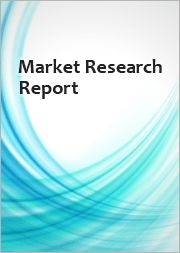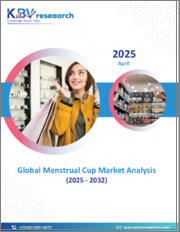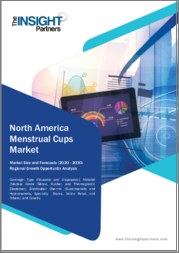
|
시장보고서
상품코드
1701624
생리컵 시장 : 시장 규모, 점유율, 동향 분석 보고서 - 재료 유형별, 유형별, 유통 채널별, 지역별, 부문 예측(2025-2030년)Menstrual Cup Market Size, Share & Trends Analysis Report By Material Type (Silicone, Thermoplastic Elastomer, Latex Rubber), By Type, By Distribution Channel, By Region, And Segment Forecasts, 2025 - 2030 |
||||||
생리컵 시장 규모 및 동향 :
세계의 생리컵 시장 규모는 2024년 8억 6,500만 달러로 평가되었고, 2025-2030년 연평균 복합 성장률(CAGR) 5.6%를 나타낼 것으로 예측됩니다. 생리컵 산업의 성장의 주된 이유 중 하나는 환경 의식이 높아지는 것입니다. 생리대나 탐폰과 같은 기존 생리용품은 생분해성이 없는 폐기물에 크게 공헌하고 있습니다. 의료용 실리콘 등 친환경 소재로 만들어진 생리컵은 최장 10년간 재사용이 가능하며 생리 폐기물을 대폭 삭감합니다. 이는 지속 가능성을 촉진하고 환경에 미치는 영향을 줄이기 위한 세계의 노력과 일치합니다. 지속 가능한 대체품을 장려하는 정부의 정책과 캠페인은 이 동향을 더욱 뒷받침하고 있습니다.
생리컵은 탐폰이나 생리대과 같은 일회용 제품에 비해 장기적으로 상당한 비용 절감이 가능합니다. 생리컵의 초기 구입 비용은 비쌀 수 있지만 재사용이 가능하기 때문에 매월 지출이 없어집니다. 이 경제적 이점은 전 세계의 소비자, 특히 경제적 여유가 우려되는 지역의 소비자에게 어필하고 있습니다. 게다가 온라인 플랫폼은 소비자가 가격을 비교하거나 리뷰를 읽을 수 있도록 함으로써 이러한 제품을 보다 친근하고 저렴하게 만들었습니다.
생리대 및 탐폰에 포함된 화학물질과 향료에 노출되는 등 기존의 생리용품과 관련된 건강 위험에 대한 우려가 높아져 생리컵과 같은 안전한 대체품으로 소비자를 향하게 하고 있습니다. 이 제품들은 유해한 화학물질을 포함하지 않고, 톡식 쇼크 증후군(TSS)을 일으킬 위험도 낮습니다. 헬스케어 제공자나 건강에 초점을 맞춘 미디어로부터의 지지는, 보다 안전한 선택지로서의 생리컵에 대한 소비자의 신뢰를 한층 더 높이고 있습니다.
생리 건강에 관한 교육적 이니셔티브 증가는 시장 성장에 매우 중요한 역할을 하고 있습니다. 정부, NGO, 기업은, 학교, 지역사회, 온라인 플랫폼을 대상으로 한 캠페인을 통해서, 생리위생에 관한 인식을 적극적으로 촉진하고 있습니다. 이러한 대처는, 생리컵의 이점에 대해 여성을 교육할 뿐만 아니라, 생리에 관련되는 문화적 금기를 깨는 것에도 도움이 되고 있습니다. 생리용품의 면세나 학교에서의 무료 배포라고 하는 정책도, 보급에 공헌하고 있습니다.
생리컵 디자인의 끊임없는 기술 혁신은 편안함과 사용 편의성을 향상시켜 더 많은 사람들에게 매력적인 제품입니다. 제조업체는, 개인의 요구에 맞추어 다양한 사이즈나 형상을 제공하는 것으로, 커스터마이즈에 힘을 쓰고 있습니다. 의료용 실리콘과 같은 고급 소재를 사용함으로써 내구성과 안전성을 확보하면서 사용감을 향상시키고 있습니다. 이러한 기술 혁신은 쾌적함과 사용 편의성에 관한 소비자의 우려에 대응함으로써 시장을 확대해 왔습니다.
여성용 위생 제품에 대한 접근성을 개선하기 위한 정부의 이니셔티브는 시장 성장에 큰 영향을 미칩니다. 예를 들면, 미국의 Menstrual Equity for All Act와 같은 규제의 대처는 생리컵과 같은 재사용 가능한 선택사항에 대한 접근을 촉진합니다. 또한 제조업체와 정부 및 교육기관과의 협력은 특히 문화적 편견이 아직 존재하는 신흥국 시장에서 미개척 시장으로 이러한 제품을 확대하는 데 도움이 되고 있습니다.
가장 큰 과제 중 하나는 특히 신흥 국가에서 생리컵에 대한 인식과 교육의 부족입니다. 많은 여성들은 생리컵 사용법이나 생리대 및 탐폰과 같은 기존 제품과 비교했을 때의 이점에 대해 잘 모릅니다. 이러한 지식 부족은 안전성이나 위생에 관한 오해로 이어지는 경우가 많아 잠재적인 사용자가 생리컵으로 전환하는 것을 주저하게 만들 수 있습니다. 교육 캠페인은 매우 중요하지만 코로나19 대유행 시에는 사회적 거리두기 조치로 인해 방해를 받아 생리 건강과 위생에 대해 여성에게 알리는 지원 활동이 제한되었습니다.
생리 위생 용품 시장은 경쟁이 치열하고 재사용 가능한 천 생리대 및 생리용 속옷 등 다양한 대체품이 인기를 끌고 있습니다. 이러한 대체품은 생리컵보다 사용하기 쉽거나 쾌적하거나 하는 소비자에게 어필하는 경우가 많습니다. 그 결과, 이러한 경쟁 제품의 존재는 특히 새로운 것을 시도하는 것을 주저하는 소비자들 사이에서 생리컵의 시장 침투를 제한할 가능성이 있습니다.
목차
제1장 조사 방법 및 범위
제2장 주요 요약
제3장 생리컵 시장의 변수, 동향 및 범위
- 시장 계통 전망
- 침투 및 성장의 전망 매핑
- 업계 밸류체인 분석
- 원재료 전망
- 제조업 및 기술의 동향
- 판매 채널 분석
- 이익률 분석
- 시장 역학
- 시장 성장 촉진요인 분석
- 시장 성장 억제요인 분석
- 시장 기회
- 시장의 과제
- 업계 분석-Porter's Five Forces 분석
- 시장 진출 전략
제4장 생리컵 시장 : 재료 유형별 추정 및 동향 분석
- 생리컵 시장 : 주요 포인트
- 변동 분석 및 시장 점유율(2024년, 2030년)
- 재료 유형별(2018-2030년)
- 실리콘
- 열가소성 엘라스토머
- 라텍스
- 고무
제5장 생리컵 시장 : 유형별 추정 및 동향 분석
- 생리컵 시장 : 주요 포인트
- 변동 분석 및 시장 점유율(2024년, 2030년)
- 유형별(2018-2030년)
- 재사용 가능
- 일회용
제6장 생리컵 시장 : 유통별 추정 및 동향 분석
- 생리컵 시장 : 주요 포인트
- 변동 분석 및 시장 점유율(2024년, 2030년)
- 유통별(2018-2030년)
- 온라인
- 약국
- 소매
제7장 생리컵 시장 : 지역별 추정 및 동향 분석
- 생리컵 시장 : 지역별 전망
- 변동 분석 및 시장 점유율(2024년, 2030년)
- 지역별 및 국가별(2018-2030년)
- 북미
- 유럽
- 아시아태평양
- 중남미
- 중동 및 아프리카
제8장 경쟁 분석
- 주요 시장 진출기업에 의한 최근의 동향 및 영향 분석
- 기업 분류
- 참가 기업의 개요
- 재무실적
- 제품 벤치마킹
- 기업의 시장 점유율 분석(2024년)(%)
- 기업 히트맵 분석
- 전략 매핑
- 기업 프로파일
- Diva International Inc.
- Mooncup Ltd.
- Me Luna GmbH
- Lena Cup LLC
- The Flex Company
- LYV Life Inc.(Cora)
- LELOi AB(Intimina)
- Blossom Cup
- Fleurcup
- Lune Group Oy Ltd.
- Lunette Menstrual Cup(Peptonic Medical AB)
- Jaguara sro(LadyCup)
- YUUKI Company sro
- Ruby Cup
- Saalt
- The Keeper, Inc.
- Sirona Hygiene Private Limited
- SochGreen
- Redcliffe Hygiene Private Limited
- Procter &Gamble
Menstrual Cup Market Size & Trends:
The global menstrual cup market size was estimated at USD 865.0 million in 2024 and is expected to grow at a CAGR of 5.6% from 2025 to 2030. One of the primary reasons for the growth of the menstrual cup industry is the heightened environmental awareness. Traditional menstrual products like pads and tampons contribute significantly to non-biodegradable waste. Menstrual cups, made from eco-friendly materials such as medical-grade silicone, are reusable for up to 10 years, drastically reducing menstrual waste. This aligns with global efforts to promote sustainability and reduce environmental impact. Government policies and campaigns encouraging sustainable alternatives further bolster this trend.
Menstrual cups offer significant long-term cost savings compared to disposable products like tampons and pads. While the initial purchase cost of a menstrual cup may be higher, its reusability eliminates recurring monthly expenses. This economic advantage appeals to consumers globally, especially in regions where affordability is a concern. Additionally, online platforms have made these products more accessible and affordable by allowing consumers to compare prices and read reviews.
Growing concerns about the health risks associated with traditional menstrual products, such as exposure to chemicals and fragrances in pads and tampons, have driven consumers toward safer alternatives like menstrual cups. These products are free from harmful chemicals and have a lower risk of causing toxic shock syndrome (TSS). Endorsements from healthcare providers and health-focused media have further increased consumer trust in menstrual cups as a safer option.
The rise in educational initiatives about menstrual health has played a pivotal role in market growth. Governments, NGOs, and corporations are actively promoting awareness about menstrual hygiene through campaigns targeting schools, communities, and online platforms. These efforts not only educate women about the benefits of menstrual cups but also help break cultural taboos surrounding menstruation. Policies such as tax exemptions on menstrual products or free distribution in schools have also contributed to wider adoption.
Continuous innovation in menstrual cup design has enhanced comfort and usability, making them more appealing to a broader audience. Manufacturers are focusing on customization by offering various sizes and shapes to suit individual needs. The use of advanced materials like medical-grade silicone ensures durability and safety while improving user experience. Such innovations have expanded the market by addressing consumer concerns about comfort and ease of use.
Government initiatives aimed at improving access to feminine hygiene products have significantly influenced market growth. For example, regulatory efforts like the Menstrual Equity for All Act in the U.S. promote access to reusable options like menstrual cups. Additionally, collaborations between manufacturers and governments or educational institutions help expand the reach of these products into untapped markets, especially in developing regions where cultural stigmas still exist.
One of the most significant challenges is the lack of awareness and education regarding menstrual cups, particularly in developing countries. Many women are unfamiliar with how to use menstrual cups or their benefits compared to traditional products like pads and tampons. This lack of knowledge often leads to misconceptions about safety and hygiene, which can deter potential users from making the switch. Educational campaigns are crucial but have been hampered by social distancing measures during the COVID-19 pandemic, limiting outreach efforts to inform women about menstrual health and hygiene.
The market for menstrual hygiene products is highly competitive, with various alternatives such as reusable cloth pads and period underwear gaining popularity. These alternatives often appeal to consumers who may find them easier to use or more comfortable than menstrual cups. As a result, the presence of these competing products can limit the market penetration of menstrual cups, particularly among those who are hesitant to try something new.
Global Menstrual Cup Market Report Segmentation
This report forecasts revenue growth globally, regionally, and country-wide and analyzes the latest industry trends and opportunities in each sub-segment from 2018 to 2030. Grand View Research has segmented the global menstrual cup market report by material type, type, distribution channel, and region:
- Material Type Outlook (Revenue, USD Million, 2018 - 2030)
- Silicone
- Thermoplastic
- Latex
- Rubber
- Type Outlook (Revenue, USD Million, 2018 - 2030)
- Reusable
- Disposable
- Distribution Channel Outlook (Revenue, USD Million, 2018 - 2030)
- Online Stores
- Pharmacies
- Retail Stores
- Regional Outlook (Revenue, USD Million, 2018 - 2030)
- North America
- U.S.
- Canada
- Mexico
- Europe
- Germany
- UK
- France
- Italy
- Spain
- Asia Pacific
- China
- Japan
- India
- Australia & New Zealand
- South Korea
- Central & South America
- Brazil
- Middle East & Africa
- UAE
Table of Contents
Chapter 1. Methodology and Scope
- 1.1. Market Segmentation & Scope
- 1.2. Market Definition
- 1.3. Information Procurement
- 1.3.1. Purchased Database
- 1.3.2. GVR's Internal Database
- 1.3.3. Secondary Sources & Third-Party Perspectives
- 1.3.4. Primary Research
- 1.4. Information Analysis
- 1.4.1. Data Analysis Models
- 1.5. Market Formulation & Data Visualization
- 1.6. Data Validation & Publishing
Chapter 2. Executive Summary
- 2.1. Market Outlook
- 2.2. Material Type Outlook
- 2.3. Type Outlook
- 2.4. Distribution Channel Outlook
- 2.5. Competitive Landscape Outlook
Chapter 3. Menstrual Cup Market Variables, Trends & Scope
- 3.1. Market Lineage Outlook
- 3.2. Penetration & Growth Prospect Mapping
- 3.3. Industry Value Chain Analysis
- 3.3.1. Raw Material Outlooks
- 3.3.2. Manufacturing and Technology Trends
- 3.3.3. Sales Channel Analysis
- 3.3.4. Profit Margin Analysis
- 3.4. Market Dynamics
- 3.4.1. Market Driver Analysis
- 3.4.2. Market Restraint Analysis
- 3.4.3. Market Opportunities
- 3.4.4. Market Challenges
- 3.5. Industry Analysis - Porter's Five Forces Analysis
- 3.6. Market Entry Strategies
Chapter 4. Menstrual Cup Market: Material Type Estimates & Trend Analysis
- 4.1. Material Type Market, by Material Type : Key Takeaways
- 4.2. Material Type Movement Analysis & Market Share, 2024 & 2030
- 4.3. Market Estimates & Forecasts, by Material Type , 2018 - 2030 (USD Million)
- 4.3.1. Silicone
- 4.3.1.1. Market estimates and forecast, 2018 - 2030 (USD Million)
- 4.3.2. Thermoplastic Elastomer
- 4.3.2.1. Market estimates and forecast, 2018 - 2030 (USD Million)
- 4.3.3. Latex
- 4.3.3.1. Market estimates and forecast, 2018 - 2030 (USD Million)
- 4.3.4. Rubber
- 4.3.4.1. Market estimates and forecast, 2018 - 2030 (USD Million)
- 4.3.1. Silicone
Chapter 5. Menstrual Cup Market: Type Estimates & Trend Analysis
- 5.1. Menstrual Cup Market, by Type: Key Takeaways
- 5.2. Type Movement Analysis & Market Share, 2024 & 2030
- 5.3. Market Estimates & Forecasts, by Type, 2018 - 2030 (USD Million)
- 5.3.1. Reusable
- 5.3.1.1. Market estimates and forecast, 2018 - 2030 (USD Million)
- 5.3.2. Disposable
- 5.3.2.1. Market estimates and forecast, 2018 - 2030 (USD Million)
- 5.3.1. Reusable
Chapter 6. Menstrual Cup Market: Distribution Estimates & Trend Analysis
- 6.1. Menstrual Cup Market, by Distribution: Key Takeaways
- 6.2. Distribution Movement Analysis & Market Share, 2024 & 2030
- 6.3. Market Estimates & Forecasts, by Distribution, 2018 - 2030 (USD Million)
- 6.3.1. Online
- 6.3.1.1. Market estimates and forecast, 2018 - 2030 (USD Million)
- 6.3.2. Pharmacy
- 6.3.2.1. Market estimates and forecast, 2018 - 2030 (USD Million)
- 6.3.3. Retail
- 6.3.3.1. Market estimates and forecast, 2018 - 2030 (USD Million)
- 6.3.1. Online
Chapter 7. Menstrual Cup Market: Regional Estimates & Trend Analysis
- 7.1. Menstrual Cup Market: Regional Outlook
- 7.2. Regional Movement Analysis & Market Share, 2024 & 2030
- 7.3. Market Estimates & Forecasts, by Region & Country, 2018 - 2030 (USD Million)
- 7.3.1. North America
- 7.3.1.1. Market estimates and forecast, 2018 - 2030 (USD Million)
- 7.3.1.2. U.S.
- 7.3.1.2.1. Key country dynamics
- 7.3.1.2.2. Market estimates and forecast, 2018 - 2030 (USD Million)
- 7.3.1.3. Canada
- 7.3.1.3.1. Key country dynamics
- 7.3.1.3.2. Market estimates and forecast, 2018 - 2030 (USD Million)
- 7.3.1.4. Mexico
- 7.3.1.4.1. Key country dynamics
- 7.3.1.4.2. Market estimates and forecast, 2018 - 2030 (USD Million)
- 7.3.2. Europe
- 7.3.2.1. Market estimates and forecast, 2018 - 2030 (USD Million)
- 7.3.2.2. Germany
- 7.3.2.2.1. Key country dynamics
- 7.3.2.2.2. Market estimates and forecast, 2018 - 2030 (USD Million)
- 7.3.2.3. UK
- 7.3.2.3.1. Key country dynamics
- 7.3.2.3.2. Market estimates and forecast, 2018 - 2030 (USD Million)
- 7.3.2.4. France
- 7.3.2.4.1. Key country dynamics
- 7.3.2.4.2. Market estimates and forecast, 2018 - 2030 (USD Million)
- 7.3.2.5. Italy
- 7.3.2.5.1. Key country dynamics
- 7.3.2.5.2. Market estimates and forecast, 2018 - 2030 (USD Million)
- 7.3.2.6. Spain
- 7.3.2.6.1. Key country dynamics
- 7.3.2.6.2. Market estimates and forecast, 2018 - 2030 (USD Million)
- 7.3.3. Asia Pacific
- 7.3.3.1. Market estimates and forecast, 2018 - 2030 (USD Million)
- 7.3.3.2. China
- 7.3.3.2.1. Key country dynamics
- 7.3.3.2.2. Market estimates and forecast, 2018 - 2030 (USD Million)
- 7.3.3.3. Japan
- 7.3.3.3.1. Key country dynamics
- 7.3.3.3.2. Market estimates and forecast, 2018 - 2030 (USD Million)
- 7.3.3.4. India
- 7.3.3.4.1. Key country dynamics
- 7.3.3.4.2. Market estimates and forecast, 2018 - 2030 (USD Million)
- 7.3.3.5. Australia & New Zealand
- 7.3.3.5.1. Key country dynamics
- 7.3.3.5.2. Market estimates and forecast, 2018 - 2030 (USD Million)
- 7.3.3.6. South Korea
- 7.3.3.6.1. Key country dynamics
- 7.3.3.6.2. Market estimates and forecast, 2018 - 2030 (USD Million)
- 7.3.4. Central & South America
- 7.3.4.1. Market estimates and forecast, 2018 - 2030 (USD Million)
- 7.3.4.2. Brazil
- 7.3.4.2.1. Key country dynamics
- 7.3.4.2.2. Market estimates and forecast, 2018 - 2030 (USD Million)
- 7.3.5. Middle East & Africa
- 7.3.5.1. Market estimates and forecast, 2018 - 2030 (USD Million)
- 7.3.5.2. UAE
- 7.3.5.2.1. Key country dynamics
- 7.3.1. North America
Chapter 8. Competitive Analysis
- 8.1. Recent Developments & Impact Analysis, by Key Market Participants
- 8.2. Company Categorization
- 8.3. Participant's Overview
- 8.4. Financial Performance
- 8.5. Product Benchmarking
- 8.6. Company Market Share Analysis, 2024 (%)
- 8.7. Company Heat Map Analysis
- 8.8. Strategy Mapping
- 8.9. Company Profiles
- 8.9.1. Diva International Inc.
- 8.9.2. Mooncup Ltd.
- 8.9.3. Me Luna GmbH
- 8.9.4. Lena Cup LLC
- 8.9.5. The Flex Company
- 8.9.6. LYV Life Inc. (Cora)
- 8.9.7. LELOi AB (Intimina)
- 8.9.8. Blossom Cup
- 8.9.9. Fleurcup
- 8.9.10. Lune Group Oy Ltd.
- 8.9.11. Lunette Menstrual Cup (Peptonic Medical AB)
- 8.9.12. Jaguara s.r.o. (LadyCup)
- 8.9.13. YUUKI Company s.r.o.
- 8.9.14. Ruby Cup
- 8.9.15. Saalt
- 8.9.16. The Keeper, Inc.
- 8.9.17. Sirona Hygiene Private Limited
- 8.9.18. SochGreen
- 8.9.19. Redcliffe Hygiene Private Limited
- 8.9.20. Procter & Gamble
(주말 및 공휴일 제외)


















